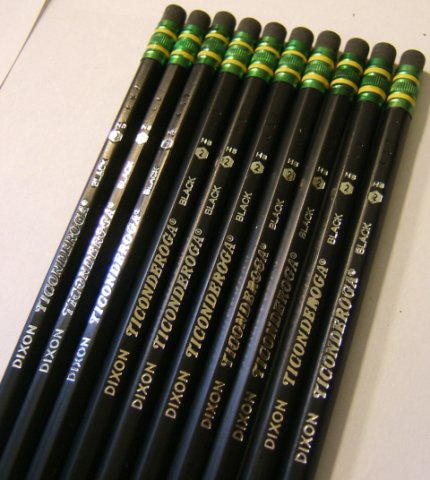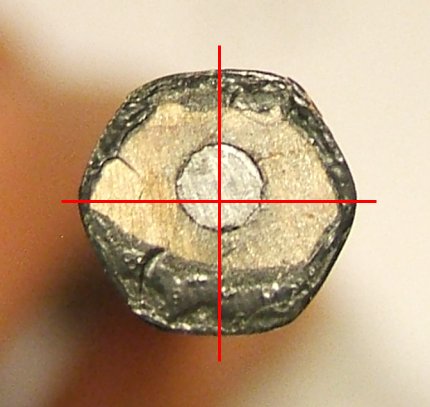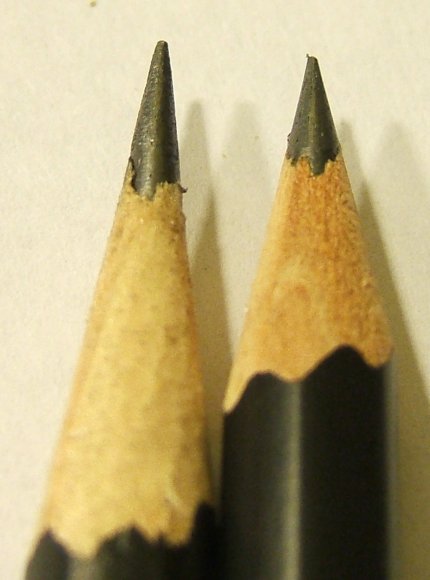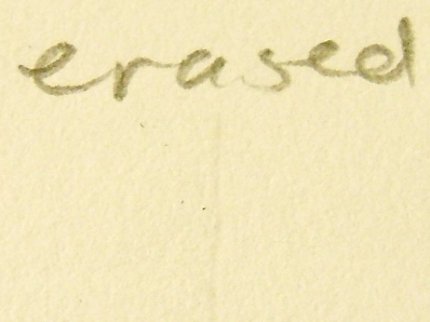The Dixon Ticonderoga is a well known pencil. Who doesn’t remember picking up one of these pencils during their school years and scribbling down an answer to a math problem or circling the correct word to complete a sentence? Their yellow and green contrasting colors made them stand out against other brands. I remember thinking just how cool that contrast was. Only a mechanical pencil could top a Ticonderoga.
A lot has changed since those days and the Ticonderoga is no exception. Now the famous pencil is made outside the US, comes in a new triangular shape for those who prefer it, and in some cases is painted black. Fear not though! According to Dixon’s website, the famously recognizable yellow pencil is still available. Even when painted black, the Ticonderoga still stands out from its competitors. Dixon smartly kept the green color scheme on their plastic packaging. What ever happened to the paper cartons? I remember a picture of an American Minute Man marching on the packaging and I thought that was so cool too! As an immigrant, it helped me identify with being an American kid.
I picked up a pack of 24 black Ticonderogas from Walmart. At $3.44 (excluding local taxes), the unit price comes out to slightly more then $0.14 per pencil. The pencils are also available in more and less counts that decreases and increases the unit price. I couldn’t imagine buying a pack of 48 and 6 didn’t seem like enough for my trials. The pencils are also widely available at Office Depot and Staples although I don’t remember the prices that I saw there. Of course, I’m sure someone sells these online as well.
First impressions. The history and background of the Dixon Ticonderoga is of no secret to anyone and it is well documented on Dixon’s own website and on Wikipedia. I will not go into it here as I would simply be repeating what has already been stated over and over again. Suffice it to say that an Italian company called Fila owns the American brand and company Dixon and manufactures it’s signature Ticonderoga model in Mexico among other places. Who says NAFTA doesn’t work? Just ask Mexico.
Dixon tries to show that their pencil is a premium product. They made a point to state, before all other features, that the pencil is made of cedar (vs. who knows what other kind of wood). Small symbols on the packaging state that the wood is made from sustained forests and that the pencil is non-toxic. People who suffer from latex allergies will be pleased to know that the erase is (according the same packaging) latex-free. So not only are they appealing to those who have used their product in the past through their smart color scheme but they appeal to environmentalists in stating the wood is from sustained growth forests which are responsibly managed and to latex allergy sufferers who would otherwise avoid the product. Dixon wants to make sure that everyone can own a Ticonderoga. No excuses!
I was surprised by the fruity smell coming out of the packaging once I opened it. It seems like it was emanating from the latex free erasers. I always remembered pencils smelling woody and dirty. The scent fades pretty quick in the open air though. Pity. The black lacquer has a smooth matte finish which feels comfortable to the touch. Almost none of the grain is visible which implies that the finish is very thick and the wood case is sanded (or really smoothly cut) before application. There are no major splotches or runs in the coating and it looks uniform. I noticed that some of the lacquer flakes off after handling the pencils. My desk has a black surface so I lined it some sheets of white paper for better contrast. After a while, the paper was covered in little black flakes. My hands also had some black flakes stuck to them. I checked the pencils to see where the flakes came from but it wasn’t very obvious. The finish still seemed smooth and consistent. Perhaps the flakes are coming from the ends of the pencils? Wait… what?
One disappointment comes from quickly glancing at the unsharpened ends. There is plenty of lacquer spilling over. I want to say that it looks sloppy. However, for the great majority of users this probably leaves no negative impression. After all, it will disappear after the first sharpening. I also understand how difficult it can be to create a clean cut (stay tuned for my next post on this). Some manufacturers can do this so I can’t say it’s impossible with modern machinery. Dixon is trying to keep costs down by removing a step in the manufacturing process that would otherwise give a clean appearance at the end of the pencil. Cosmetic ding #1.
Taking a closer look at the ends of the pencils, I see that the lead is not always centered in the wood casing. I’m not sure if this is just a warped lead or an uneven cut in the case. Either way, something is not right. Would this have an impact on the structural integrity of the lead? Is the lead more likely to break now? I will set this pencil aside for now. Quality ding #1.
The silver stamping is, for the most part, clear and centered on a flat side of the hexagonal shape. In some cases, the stamping looks smudged or slightly cropped at the top or bottom of the text. Rub hard enough and it will come off. Again, for most, this is a “don’t care” but for the careful eye it is another cosmetic deficiency. Cosmetic ding #2
The ferrules are nicely and evenly crimped. There is no noticeable gap between the ferrule and pencil and between the ferrule and eraser. None of the ferrules or erasers wobble. I appreciate the 360 degree crimping because it seems to give the ferrule it’s strong grip to both the pencil and the eraser. One of the pencils showed some air bubbles and debris that were trapped under the yellow paint on the otherwise green (seemingly) anodized ferrule. Perhaps this is an indication of poor process control. Again, we are drawn to the same question, would the masses even notice or care about this? Cosmetic ding #3.
I set four of the pencils aside to take to work. To my surprise, one of them was warped! I would not have noticed this except for when I tried to playfully roll it down my paper pad. This is very unexpected, especially from a Dixon. This is another pencil to set aside for further examination. Fortunately, the other 23 pencils seem straight. Quality ding #2.
I decided to sharpen two of these pencils. One was sharpened in an old Berol Chicago APSCO Sharpener and the other was sharpened with a brand new German made Faber Castell multi dimensional sharpener. I have seen the Faber Castell model re-branded to other names so I’m not sure who the original manufacturer is. It is made in Germany according to text found on the packaging, on the casing, and on the blades. I found that the wood chipped off in both pencils and lost contact to the lead in one spot. It seems to be the same spot on both pencils so I can’t say that it is caused by a specific sharpener. Otherwise, one would have it and one wouldn’t. Upon closer inspection, the lead still appears solid and secure. It’s an issue more of cosmetics than structural integrity but it can be noticed by those who look for it – and you don’t need to look hard. Cosmetic ding #4.
I bought a nice big hardbound notebook made by Strathmore. They claim it is a sketchbook but I really can’t tell you what that means. Does that mean that the paper fibers are finer? The paper is very white, acid free, and comes in a 60 lbs. weight. I figure it would be nice to have something like this to document all of my writing experiments. An artist I am not so don’t expect anything more than scribbles and stick figures here!
Writing with the pencil is fun. It feel slender and well balanced. The lines are decently dark for a #2HB and the feedback is soft and smooth. In my short writing time with this pencil so far I did not ever feel any sort of sand or grit in the lead as I do with the cheap Chinese pencils here at work. The point seems to hold for quite some time before you would think of resharpening it.
I was surprised at how difficult it is to photograph a close up of the markings. My camera, even in macro mode, does not allow very close ranges. I used a very small aperture for a pinhole camera effect. This would decrease my focus distance but only for a small spot. Macro photography requires a lot of light so that is why the pictures are a little dark.
The black latex free eraser works well and leaves little residue. All of the markings were neatly picked up off the paper leaving only a dim indent on the paper from the pencil. Coloring the eraser black was a good move by Dixon. Not only does it match the general color scheme but it hides any graphite smudges that would otherwise be picked up by a traditionally red eraser. The soft eraser does not feel abrasive during use and a close examination of the paper after use verifies this.
I have only briefly touched upon the three characteristics of materials, manufacturing, and process. There is still so much more. If this were a car, we have only begun our test drive by sitting in the seat and driving around the neighborhood. Now it is time to look under the hood and under the car itself to see what we can see! Stay tuned!









